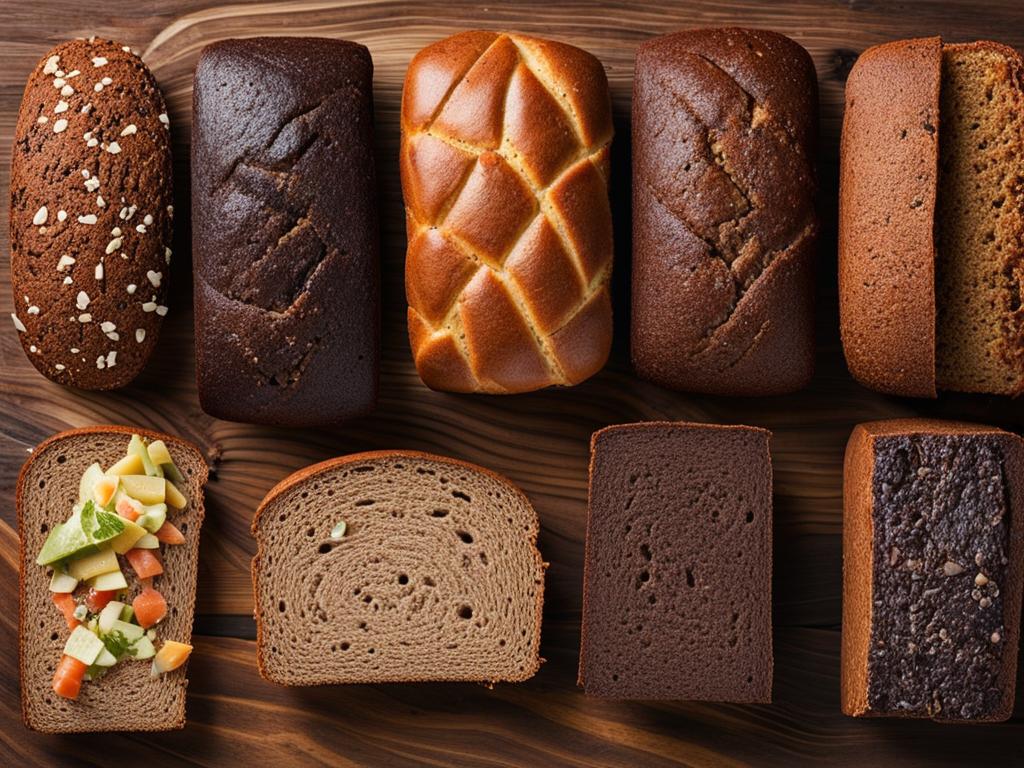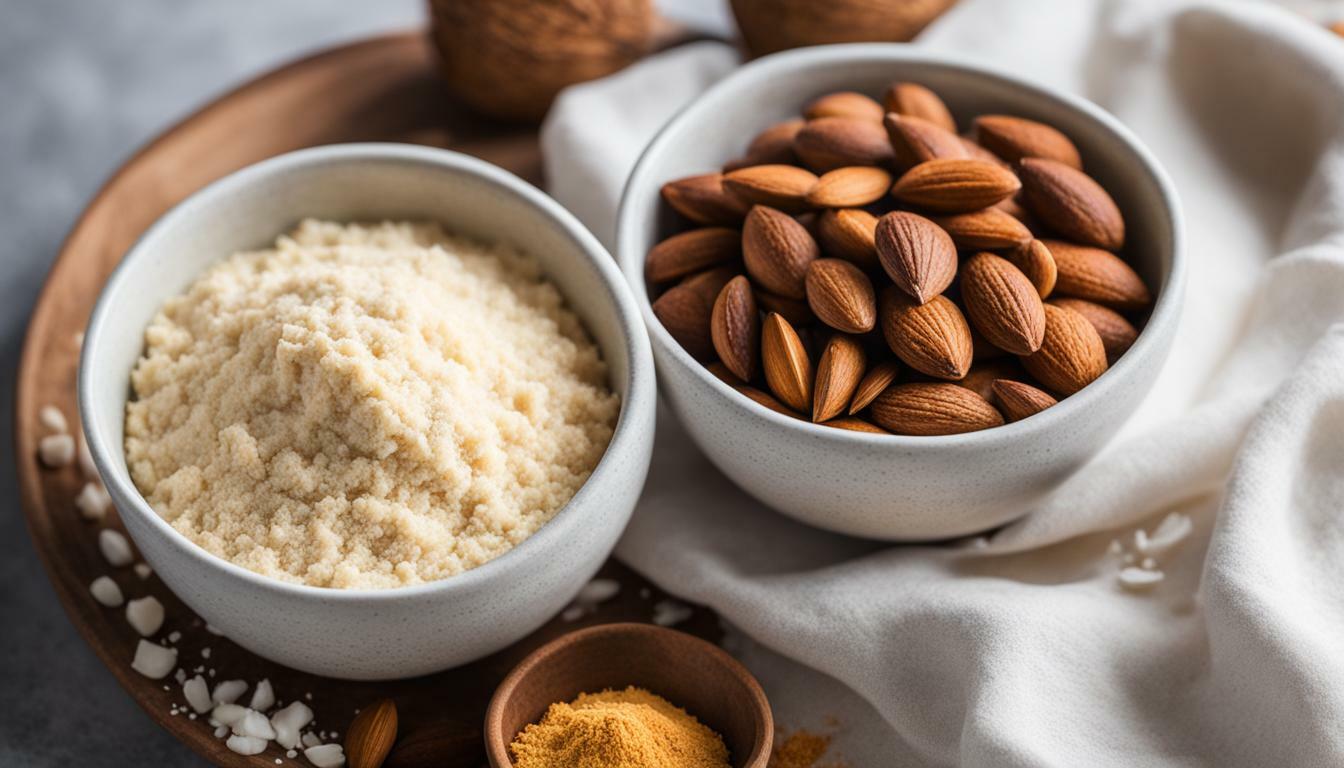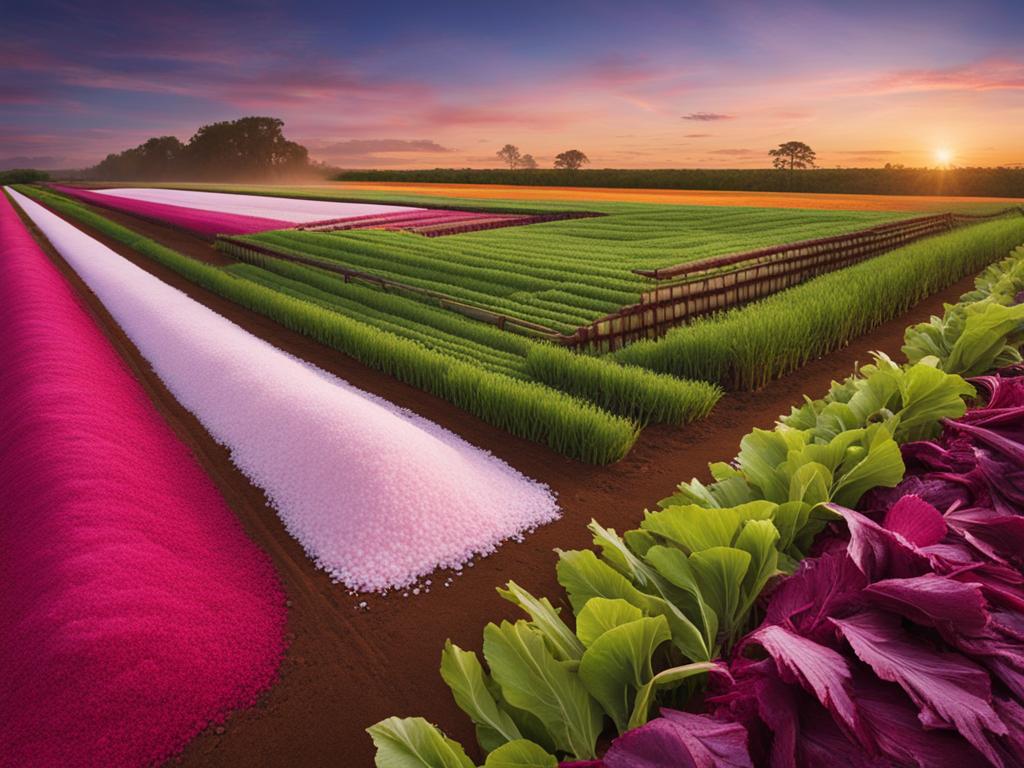Rye bread and pumpernickel bread are both popular types of bread with distinct characteristics. Rye bread has its origins in ancient civilizations and is made primarily from rye flour and wheat flour. It has a darker color, denser texture, and a unique flavor profile. On the other hand, pumpernickel bread originated in Germany and is made solely from coarsely ground whole rye grains. It has a dense texture, dark color, and a robust, earthy flavor. The preparation methods and selection of ingredients differ between the two breads, resulting in their distinct flavors.
Key Takeaways:
- Rye bread is made from rye flour and wheat flour, while pumpernickel bread is made from coarsely ground whole rye grains.
- Rye bread has a darker color, denser texture, and a unique flavor profile.
- Pumpernickel bread has a dense texture, dark color, and a robust, earthy flavor.
- The preparation methods and selection of ingredients differ between the two breads, resulting in their distinct flavors.
- Rye bread originated in ancient civilizations, while pumpernickel bread originated in Germany.
Note: The image above visually represents the difference between a rye bread and a pumpernickel bread.
Ingredients and Preparation of Rye Bread
Rye bread is made using a combination of key ingredients that contribute to its distinct flavor and texture. The main ingredient, as the name suggests, is rye flour. This flour gives the bread its unique taste and denser texture compared to bread made with wheat flour alone. Other ingredients typically included in rye bread recipes are water, salt, and a leavening agent.
The fermentation process plays a vital role in the preparation of rye bread. It can be done using either a sourdough starter or yeast. Fermentation helps develop the tangy flavor that rye bread is known for. Traditional recipes may also incorporate additional ingredients like caraway seeds or other spices to enhance the bread’s flavor profile.
Once the dough is mixed and the ingredients are well combined, it is shaped into loaves or rolls. The bread is then baked until it develops a golden crust, leaving the inside moist and flavorful. The result is a delicious and hearty bread that can be enjoyed on its own or used as a base for sandwiches or toast.
The Fermentation Process:
- Combine rye flour, water, salt, and leavening agent (yeast or sourdough starter) in a mixing bowl.
- Knead the dough until it becomes smooth and elastic.
- Cover the dough and let it ferment for several hours or overnight, allowing the flavors to develop and the bread to rise.
- Shape the dough into loaves or rolls and place them on a baking sheet.
- Bake the bread at the appropriate temperature and time until it is golden brown and sounds hollow when tapped.
The table below summarizes the key ingredients and the preparation steps for rye bread:
| Ingredients | Preparation |
|---|---|
| Rye flour | Mix with water, salt, and leavening agent |
| Water | Combine with rye flour, salt, and leavening agent |
| Salt | Add to the dough mixture |
| Leavening agent (yeast or sourdough starter) | Add to the dough mixture for fermentation |
| Caraway seeds or other spices (optional) | Incorporate into the dough for additional flavor |
| Kneading and shaping | Knead the dough until smooth and elastic, then shape into loaves or rolls |
| Baking | Bake the shaped dough until golden brown |
By following these steps and using the right ingredients, you can create a delicious loaf of rye bread with its characteristic tangy flavor and dense texture.
Varieties of Rye Bread
Rye bread comes in various forms, each with its own unique characteristics. Here are some of the popular varieties of rye bread:
1. Light Rye Bread
Light rye bread is made with a combination of rye flour and wheat flour, resulting in a lighter texture and milder flavor compared to other rye breads. It is a great option for those who enjoy the taste of rye but prefer a lighter and less intense experience.
2. Dark Rye Bread
Dark rye bread is made primarily with rye flour, giving it a denser texture and a stronger, more pronounced rye flavor. It has a rich, earthy taste that pairs well with savory fillings and spreads. Dark rye bread is a popular choice for hearty sandwiches and traditional European dishes.
3. Marbled Rye Bread
Marbled rye bread combines light and dark rye doughs in a swirled pattern, creating a visually striking bread with unique flavors. The combination of light and dark rye provides a balance of milder and stronger flavors. Marbled rye bread is often used for sandwiches and toast.
4. Sourdough Rye Bread
Sourdough rye bread is made using a sourdough starter instead of yeast, resulting in a tangy and slightly acidic taste. The sourdough fermentation process gives the bread a distinct flavor profile and a chewy texture. Sourdough rye bread is prized by bread enthusiasts for its complex flavors and natural leavening.
These are just a few examples of the diverse varieties of rye bread available. Each variety offers its own unique taste and texture, allowing individuals to find the perfect rye bread to suit their preferences.

Ingredients and Preparation of Pumpernickel Bread
Pumpernickel bread is a unique and flavorful bread that is made using specific ingredients and preparation methods. The key ingredient in pumpernickel bread is pumpernickel flour, which is made from coarsely ground whole rye grains. This gives the bread its characteristic dense texture and rich, earthy flavor. Unlike other breads that use a combination of flours, pumpernickel bread exclusively relies on pumpernickel flour.
The preparation of pumpernickel bread involves a slow fermentation process to develop its distinct flavors. The dough is mixed and left to ferment for an extended period, often up to 24 hours. This allows the flavors to deepen and develop, resulting in the unique taste of pumpernickel bread. The bread is then slow-baked at a low temperature for a prolonged time, further enhancing its dark color and dense texture.
“Pumpernickel bread is known for its rich, earthy flavor and dense texture. The slow fermentation process and extended baking time contribute to the unique characteristics of this bread.”
Traditional recipes for pumpernickel bread may also incorporate bread crumbs from previously baked rye loaves, adding depth of flavor and texture. The addition of these bread crumbs gives the bread a slightly sweeter taste and a softer crumb. Pumpernickel bread is often enjoyed with various toppings, such as smoked salmon or creamy spreads, allowing for a versatile and delicious culinary experience.
Varieties of Pumpernickel Bread
Pumpernickel bread comes in various forms, each with its own distinct qualities and regional variations. One of the most well-known varieties is Westphalian pumpernickel, which is the traditional type that originates from Westphalia, Germany. It undergoes a long baking process and has a dense texture, robust flavor, and a dark color.
American pumpernickel is another popular variation that may incorporate a blend of rye and wheat flour. It can also include additional ingredients such as molasses or cocoa powder, giving it a slightly sweeter or chocolatey taste. Scandinavian pumpernickel, on the other hand, often includes a combination of rye flour, whole grains, and sweeteners, resulting in a milder and slightly sweeter flavor profile.
Sourdough pumpernickel is a unique variation that uses a sourdough starter instead of yeast. This adds a tangy twist to the traditional recipe, resulting in a bread with a slightly acidic taste that complements the earthy flavors of pumpernickel.
The table below provides a summary of the key differences between the varieties of pumpernickel bread:
| Variety | Ingredients | Flavor | Texture |
|---|---|---|---|
| Westphalian Pumpernickel | Pumpernickel flour | Robust and earthy | Dense |
| American Pumpernickel | Rye and wheat flour, sometimes molasses or cocoa powder | Slightly sweeter or chocolatey | Dense |
| Scandinavian Pumpernickel | Rye flour, whole grains, sweeteners | Milder and slightly sweeter | Dense |
| Sourdough Pumpernickel | Pumpernickel flour, sourdough starter | Tangy and slightly acidic | Dense |
Each variety of pumpernickel bread offers its own unique taste and texture, allowing individuals to choose the one that best suits their preferences. Whether you prefer the robust and earthy flavors of Westphalian pumpernickel or the tanginess of sourdough pumpernickel, these breads are sure to provide a delightful culinary experience.

| Variety | Description |
|---|---|
| Westphalian Pumpernickel | The traditional type of pumpernickel bread made from coarsely ground whole rye grains. It has a dense texture and robust flavor. |
| American Pumpernickel | A variation that may include a blend of rye and wheat flour, with added ingredients like molasses or cocoa powder. It has a softer texture compared to Westphalian pumpernickel. |
| Scandinavian Pumpernickel | Made with a combination of rye flour, whole grains, and sweeteners like honey or brown sugar. It has a slightly sweeter taste and a lighter texture. |
| Sourdough Pumpernickel | Made using a sourdough starter instead of yeast, resulting in a tangy and slightly acidic taste. |
Conclusion
Rye bread and pumpernickel bread are two distinct types of bread that offer unique flavors and textures. While both are made from rye, they differ in their ingredients and preparation methods, resulting in contrasting taste profiles.
Rye bread, known for its tangy and dense texture, is made with a combination of rye and wheat flour. Its fermentation process contributes to its distinct flavor, making it a popular choice for those who enjoy a hearty and robust bread.
Pumpernickel bread, on the other hand, is made solely from coarsely ground whole rye grains. Slow-baked at a low temperature, it develops a rich, earthy flavor and a dense texture. This bread offers a unique experience for those seeking a dark and hearty option.
Whether you prefer the tanginess of rye bread or the robustness of pumpernickel bread, both choices provide a range of variations to suit individual preferences. Understanding the differences between these breads allows you to make an informed choice based on your desired flavor and texture.
FAQ
What is the difference between rye bread and pumpernickel bread?
Rye bread is made from rye flour and wheat flour, while pumpernickel bread is made solely from coarsely ground whole rye grains.
What are the origins of rye bread and pumpernickel bread?
Rye bread has its origins in ancient civilizations, while pumpernickel bread originated in Germany.
What are the main ingredients used in rye bread?
Rye bread typically consists of rye flour, water, salt, and a leavening agent like yeast or sourdough starter.
What are the main ingredients used in pumpernickel bread?
Pumpernickel bread is made from coarsely ground whole rye grains and may also incorporate bread crumbs from other rye loaves.
How does the fermentation process affect the flavor of rye bread?
The fermentation process, done using a sourdough starter or yeast, contributes to the characteristic tangy taste of rye bread.
How is pumpernickel bread prepared?
Pumpernickel bread is mixed and left to ferment for an extended period, then slow-baked at a low temperature for up to 24 hours.
What are the different varieties of rye bread?
Rye bread comes in various forms, including light rye bread, dark rye bread, marbled rye bread, and sourdough rye bread.
What are the different varieties of pumpernickel bread?
The varieties of pumpernickel bread include Westphalian pumpernickel, American pumpernickel, Scandinavian pumpernickel, and sourdough pumpernickel.
 Skip to main content
Skip to main content


